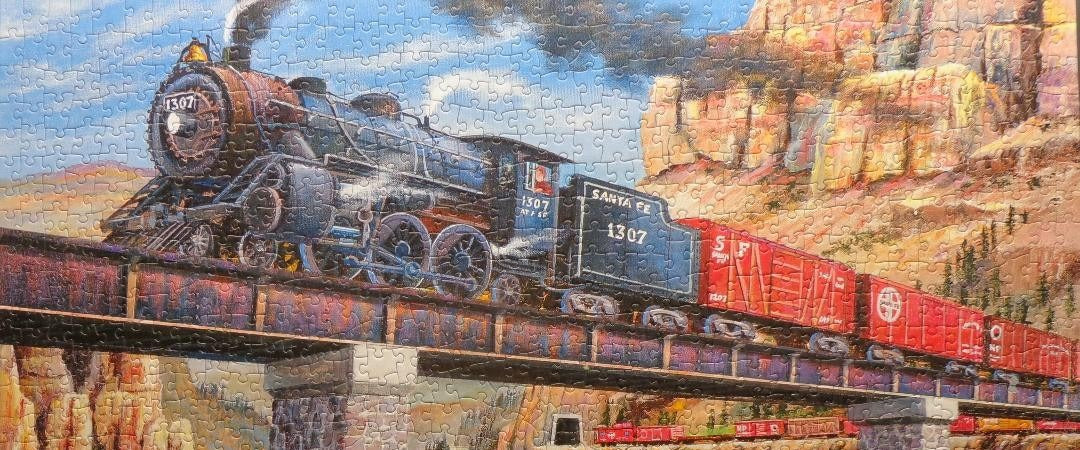
À travers les tunnels et les ruisseaux : assembler la pierre, l'acier et la vapeur
par Elmer Prather, blogueur invité
Mon dernier puzzle de mille pièces intitulé « Pierre, Acier et Vapeur » de Ken Zylla. Les images racontent une histoire, et celle-ci représente une locomotive à vapeur tirant environ vingt-cinq wagons et un fourgon de queue. Le train est un Santa Fe et la locomotive qui tire les wagons porte le numéro 1307.
Le décor se situe dans une région montagneuse, où un tunnel a été construit pour permettre aux trains de traverser cette partie de la montagne. Une section de voie ferrée enjambe un ruisseau qui coule sous la voie ferrée. Cette section est soutenue par deux poutres de soutènement en pierre et en ciment. Au XIXe siècle, ces ponts étaient construits en bois. Au fil du temps, nombre de ces ponts ferroviaires en bois ont été endommagés par des incendies ou des inondations, provoquant le déraillement de nombreux trains.

Stone Steel and Steam assemblé et photographié par Elmer Prather
Les couleurs utilisées dans ce puzzle sont superbes. Les tons rouge, marron et crème sont présents à plusieurs endroits sur l'image. C'était parfois difficile de trouver l'emplacement exact de chaque pièce, mais le puzzle était superbe une fois assemblé.
J'ai fait des recherches sur les énigmes que j'ai reconstituées et j'ai découvert plusieurs faits intéressants sur l'Atchison Topeka and Santa Fe Railway. Souvent appelé Santa Fe ou AT7SF, il fut l'un des plus grands chemins de fer de classe 1 des États-Unis entre 1859 et 1996. Ce chemin de fer a été affrété en février 1859 pour desservir les villes d'Atchison et Topeka, au Kansas, et de Santa Fe, au Nouveau-Mexique. Lors de sa construction, de nombreuses voies étaient posées directement sur les ornières de la piste de Santa Fe. Le chemin de fer a officiellement cessé son activité indépendante le 31 décembre 1996, date à laquelle il a fusionné avec le Burlington Northern Railroad pour former le Burlington Northern and Santa Fe Railway.
J'ai eu le plaisir de participer à plusieurs excursions en train à vapeur. Le son de la locomotive à vapeur sur les rails est un souvenir inoubliable. Lors de ces excursions, j'ai pu discuter avec les personnes qui entretiennent ces locomotives à vapeur et j'ai constaté qu'il s'agit d'un groupe de personnes dévouées et passionnées par leur métier. Ces excursions en train à vapeur disparaissent peu à peu. J'espère que ceux qui les maintiennent en activité continueront à assurer leur survie afin que les générations futures puissent profiter de ces merveilleux voyages.
Elmer Prather
Canton, Géorgie
USA

